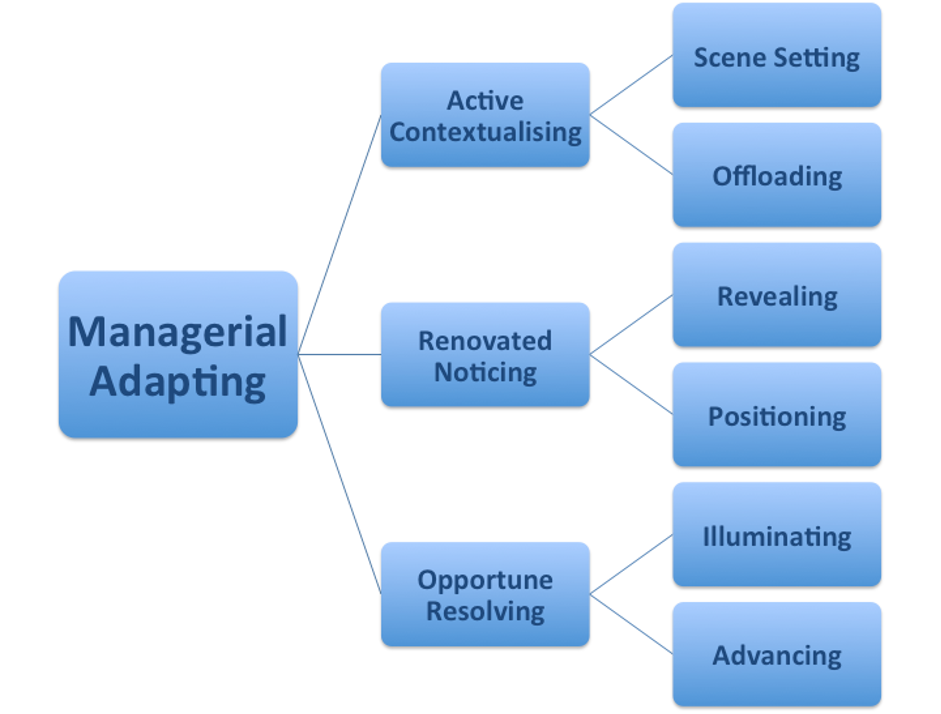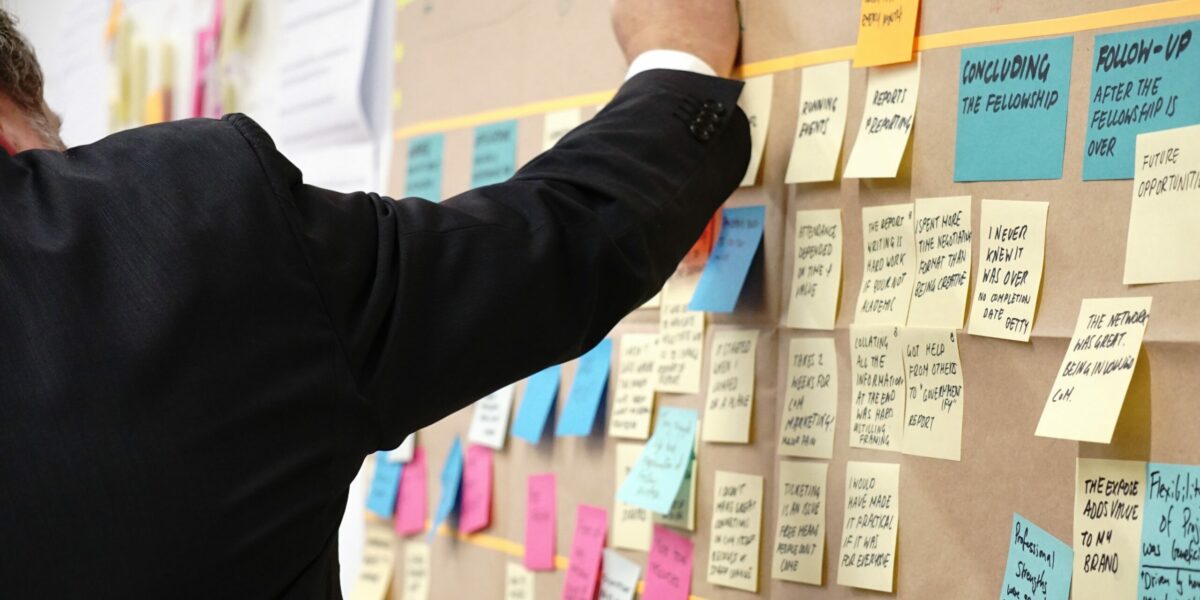This premium blog analyses empirical research data, which was undertaken to address a management competency shortfall via reflective practice documented in individual learning logs. The research was conducted in the UK division of a global manufacturing organization where the appointment of a new Managing Director with a sales background concluded a period of broad-ranging change.
The research question explored during the study was: Does reflective writing via a learning log contribute to improved management practice? Consequently there are implications for the development of a theoretical perspective.
The emergence of management decisions takes many routes within organizational practice and this study examines the contribution of learning logs as a Human Resource Development (HRD) tool to improve management practice, aid problem solving and enhance decision-making.
The findings of the research contribute to the on going academic debate regarding the value of reflective writing in the organizational setting and the practice of using learning logs in development programmes.
Managerial Adapting contributes to the ongoing academic debate on reflection and learning and it is evident from the findings that the value of reflective writing is currently misunderstood. Managerial adapting challenges the accepted norm, which associates learning logs with personal learning leading to individual transformation. Instead, categorizing reflective writing as a process that enables managers to enhance their decision-making abilities resulting in a linear and timely completion of the decision process.
The context
Wilkinson (2006) explored problem-solving success by leaders concluding that leaders create more problems than they solve. The study finding that 81% of solutions failed, were abandoned or led to severe consequences supports the phenomenon explored by Dubs (1935) as the paradox of certainty. Managers have confidence in their decision making because of the mistaken belief that they have clarity about the nature of the problem being tackled. This results in inappropriate dismissal of certain information and over reliance on obsolete patterns of thinking, entrenched control mechanisms and reliance on existing paradigms regarding cause and effect leading to failure.
In a struggling UK manufacturing business, the new Managing Director concluded extensive change was required including site relocation, business process re-engineering and structural delayering. The changes were viewed as an opportunity to disrupt business as usual, shift existing managerial paradigms, improve decision-making and develop criticality in managerial practice. Ambitious performance measures were introduced resulting in the emergence of a concern related to senior management problem solving and decision making competencies. A two-year Organisation Development (OD) programme was used to support individual and team development. Managers were encouraged to engage in personal reflection. Initially this was introduced as an informal procedure, however the process was subsequently formalised and the contents used as an agenda item for management meetings.
The aim of OD is to sustainably improve organizational effectiveness and move individuals and groups through the application of behavioural science methodology and social, human and group dynamic processes. There has been increasing emphasis on the importance of reflection and its role in adult learning (Meizrow et al, 1990; Schon, 1983). For the OD practitioner, reflection and the process of reflective writing, formed the basis of both self-development in the form of continuous professional development (CPD), and learning and development practice, in the form of critical reflection and learning logs by managers. During experiential interventions managers were provided with journals and encouraged to engage in personal reflection with an aspiration to transfer learning from the workshop “to the workplace in relations to aspirations about CPD and organizational learning” (Holden and Griggs, 2011: 484).
Reflection and learning logs were included as part of standard OD practice, but it was difficult to ascertain whether the use of learning logs in the interventions contributed to transformative and organizational learning leading to improved problem solving and decision making. It was not known to what extent managers used their learning logs since they were neither read, nor assessed by the OD practitioner, and were only discussed if the manager was willing to share it. Since the managers were not members of a professional body, which requires CPD for member to retain their status, there were concerns that the managers adopted an instrumental attitude toward reflective writing completing their logs superficially (Holden and Griggs, 2011) and only when the OD practitioner was present or requested that they do so. Therefore the inclusion of learning logs in development practice was ‘a matter of faith’ (Griggs et al, 2015: 203).
There has been increasing emphasis on the importance of reflection and its role in adult learning (Meizrow et al, 1990; Schon, 1983). For the OD practitioner, reflection and the process of reflective writing, formed the basis of continuous professional development (CPD), learning and development practice, in the form of critical reflection and learning logs by managers. During experiential interventions managers were provided with journals and encouraged to engage in personal reflection to transfer learning from the workshop “to the workplace in relation to aspirations about CPD and organizational learning” (Holden and Griggs, 2011: 484).
Reflection and learning logs were included as part of standard OD practice, but It was difficult to ascertain whether using learning logs in the interventions contributed to transformative and organizational learning leading to improved problem solving and decision making. It was not known to what extent managers used their learning logs since they were neither read, nor assessed and were only discussed if the manager was willing to share it. Since the managers were not members of a professional body, which requires CPD for members to retain their status, there were concerns that the managers adopted an instrumental attitude toward reflective writing completing their logs superficially (Holden and Griggs, 2011) and only when the OD practitioner was present or requested that they do so. Therefore the inclusion of learning logs in development practice was ‘a matter of faith’ (Griggs et al, 2015: 203).
This paper analyses empirical data, to address a management competency shortfall in critical thinking and questioning of existing paradigms via reflective practice documented in learning logs.
The research question is:
Does reflective writing via a learning log contribute to improved management practice?
Consequently there are implications for the development of a theoretical perspective.

Methodology
Grounded theory is the selected methodology, the rationale being that new theory is generated through using the relevant techniques, as opposed to the verification of an existing theory. This complies with the research question. This section outlines the sample and a very brief summary of the methodology.
Sample
The sample consisted of five respondents occupying management roles within the organization and represented the total organizational population working at this level. This approach is consistent with grounded theory which seeks to induct concern resolution.
Grounded Theory
Grounded theory (GT) is a stand-alone methodology, which supports the discovery of theory from data (Glaser and Strauss, 2008) via a series of analytical processes and focuses on social processes. According to Lawrence and Tar (2013:30) it is ‘a dominant paradigm for social research.’ The technique commences with the collection of one data set and analysis via coding, which is concurrent (Birks and Mills, 2013) rather than linear (Symon and Cassell, 2012) and requires a temporary suspension of matching to previous theory, conceptualized by Green and Binsardi (2014) as mental boxing.
Glaser refers to grounded theory as simply being the discovery of emerging patterns in data that explain how to resolve a main concern (Walsh et al, 2015), in a particular situation.
GT does not follow a linear process of data collection, analysis and presentation of findings, (Symon and Cassell, 2012). The literature review is used for comparison after the data analysis has been completed and a substantive theory has emerged. In GT there is a suggestion to suspend previous knowledge about the research area as induction leads to theoretical emergence from the data, (Glaser and Strauss, 1999) Green and Binsardi (2014) conceptualise this temporary suspension as mental boxing.
Idrees, Vasconcelov and Cox (2011) summarise the three generic principles of grounded theory as:
- Theoretical sampling: data collection is driven by the emerging theory and indicates where to go to next, this choice is not pre-determined.
- Constant comparison: the collection and analysis of data in a simultaneous manner, which enables data interplay to occur.
- Theoretical saturation: occurs when additional analysis no longer contributes to discovering anything new about a category.
Data Collection and Data Analysis
GT requires concurrent data collection and analysis, (Birks and Mills, 2013). As data collection and analysis is responsive in GT it provides an opportunity to process and reflect on the data and appropriateness of data being collected, directing the route of further data collection based upon what is derived during the initial data analysis. This analysis may reveal an action or a process which Glaser (2005: 2) describes as ‘processural, or, there is a ‘process out’.’ This indicates a movement from one phase to another as unfolding actions or sequences of events are captured within the form of a basic social process (Green, 2016:4).

Application of methodology
A classic Glaserian approach to GT was chosen as a research methodology to increase knowledge and understanding of the use of reflective writing, in the form of a learning log, and its subsequent impact on management practice. The purpose is to contribute to research and theoretical grounding in the fields of organisation development, learning and development, Human Resource Management (HRM) and Management practice.
As a stand-alone methodology GT offers the opportunity for a greater depth of discovery as to what happens to management practice as a result of reflective writing. The secondary appeal of the method is that it supports the discovery of how the participants ‘construct their world’ (Lawrence and Tar, 2013: 31) during the data collection and analysis process.
Data was collected over a six-week period to ascertain the use and application of reflective learning logs. Respondents were asked to use the following series of open, non-directive questions, and complete the task during a three-hour period each Friday, this enabled constant comparison to occur as data was coded. The same questions were asked each week, revealing a series of changes, which are outlined in the discussion and resulted in theoretical saturation.
- What Happened?
- What does this mean?
- How did this make you feel?
- What could you do to solve this problem in the future?
The challenge of reflective learning in management practice
Globalisation, advances in technology, work intensification, perceived environmental uncertainty and ambiguity have all had a significant impact on the nature of management practice, behaviour knowledge and skills (Rigano and Edwards, 1998; Dai et al, 2013). Effective managers are those with an ability to learn and to adapt to change, (Kolb, 1976), a view supported by Dai et al (2013) who argues that managing frequent change in the contemporary business environment requires agility and a willingness to develop new skills and apply learning from experience as core requirements for successful management practice.
Management decision-making can be explained using neo-classic economic assumptions based upon the rational actor model. This supposes an objective process of problem identification, information gathering, the generation of potential solutions and the making of an objective optimizing choice (Clegg et al, 1999). Criticisms of the rational model highlight organizational complexity, incomplete information, imperfect knowledge and lack of time available, resulting in bounded rationality, leading to decisions often based on satisficing (Clegg et al, 1999; Rizen and Taranenko, 2014).
Effective managers are those with an ability to learn and to adapt to change, (Kolb, 1976), a view supported by Dai et al (2013) who argues that managing frequent change in the contemporary business environment requires agility, a willingness to develop new skills and apply learning from experience as core requirements for successful management practice.
Schön (1983) suggests that much of management practice is based on action patterns and tacit knowledge. A lack of criticality in reflecting on routinized actions can ‘reinforce prejudices and bad practice’ and collusion with cultural assumptions within the workplace (Finlay, 2008).
Reflection
There is no single theory or agreed definition of reflection, which contributes to the development of models to operationalize it and difficulties in establishing what is or is not reflection (Finlay, 2008; Peltier, 2005; Roessger, 2014). Much of the theory is not contextualised, so the degree to which reflection has a transformative or a positive effect on management practice is questionable. (Fook et al, 2006, Roessager, 2014).
Reflection is variously described as a cognitive and emotional response to personal experiences, which results in the construction of new or revised understanding or meaning. It is recognised as a deliberate attempt by the individual to confront imperfect existing knowledge, which concludes with transformation in meaning (Peltier et al, 2005; Dewey, 1933; Schön, 1983). Three consistent elements identified by Foster and Stines (2011: 11) are ‘thinking, learning and action-orientation’ and reflection ‘is the bridge between experience and learning, involving both cognition and feelings’ (Gray, 2007: 496).
In this study reflection is defined as an active confrontation of doubt in an existing belief or assumed knowledge in reaction to an experience, leading to an adaptive inquiry and resulting in the formation of new conceptual perspectives (Dewey, 1933; Kolb, 1984; Schön, 1983; van Woerkom, 2004; Peliter et al, 2005).
The literature distinguishes between types of reflection based upon the timing of when reflection takes place, often referred to as reflection-for-action, reflection-in-action and reflection-on-action (Lynch and Metcalfe, 2006; Grushka et al, 2005; Schön, 1983; Boud and Walker, 1994).
Professionals use the retrospective process of reflection-on-action to examine current experiences, problems or situation against prior experience and understanding. (Roessger, 2004; Schön, 1983; Grushka et al, 2005). Using this process it is possible to consider how knowing-in-action is used (Schön, 1983), how this contributes to the consequences of decisions and actions made during the situation being reflected upon and change perspectives based upon the experience. For reflection-on-action to occur individuals must be intent on learning, having noticed and had personal involvement with the experience on which they wish reflect. Furthermore, for there to be a benefit from reflection it must be linked to action (Boud and Walker, 1991). Schön (1983: 61) argues that alongside the process of knowing-in-action there is a secondary process of reflection-in-action that is making ‘new sense of the situations of uncertainty or uniqueness which he may allow himself to experience.’ It is within this process that managers examine and respond to experience and draw on their knowledge of the organisation bringing context to the new situation. Based on this assertion it is feasible that the use of unguarded responses in managerial practice is tempered by the process of reflection-in-action, and therefore enables managers to be both efficient in decision-making but also effective in making critical judgements in the moment.
Reflection-in-action, (Schön, 1983) results in an action learning process judged to be necessary for effective decision-making (Peltier, 2005). However, some theoretical personality trait research suggests that although conscious thought in simple decision making led to better performance, in complex situations, intuitive and unconscious decision-making was more effective, leading to the argument that the structure of the problem was important to decision-making processes. Poor decision-making and judgements can be as a result of managers asking the wrong questions in a demanding environment (Warr, 2002; Staw, 1995). Therefore, reflection may result in managers seeking solutions to the wrong problem. By not asking the systemic question, managers may be fixing symptoms rather than core problems.
Boud et al (1985) describe a three-step reflection process; return to experience, analysis and re-evaluation. This process has parallels to Lewin’s (1947) three-step change process; unfreeze, change, freeze in that the initial stage requires a readiness to change and a willingness on behalf of the individual to confront their initial mental structures and habits of mind (Meizrow, 1990). The analysis stage of reflection aligns with the implementation stage offered by Lewin, requiring the individual to invest in a transition stage, which may be chaotic. Finally the freeze and re-evaluation stages relate to a permanent outcome incorporating the changes made during the transition. Schön (1983) also uses a similar three stage process of reflection-in-action; appreciation, action and re-appreciation. Although direct comparisons are not made, the inclusion of the concept of change in the reflection process is present in the work of a number of theorists. (Peltier et al, 2005; Schön, 1983) Since the reflection process itself is a change process, it could be contested that learning activities should result in changes to management practice.
Learning
Learning is described as a cognitive and physical activity involving an individual’s perception of an experience and their contribution to a situation where the individual discovers a ‘personal relationship to and with people, things and ideas’ (Knowles, 2015: 108). The process of learning involves the adaptation of understanding, revision of meaning and appreciation leading to a permanent change in knowledge, skills, attitude and behaviour, resulting in action (Boud and Walker, 1991; Meizrow, 1990; Warr, 2002). In this study learning is defined as a process which occurs following a transforming experience, that results in the learner acquiring knowledge and skills and developing attitudes, values and belief.
Learning from experience is highly iterative and is an active process. What learning occurs during that process depends on the individual, the intent, the task and the context (Boud and Walker, 1991). Moon (2006: 21) suggests, ‘all learning is learning from experience’ However, Hilden and Tikkamaki (2013) and Silva (2012) argue that reflection is an essential component, which should be trained because not all experience results in learning. Readiness to learn operates on the basis of an individual paying attention to intense and diverse experiences if they highlight an immediate developmental requirement (Luo and Peng, 1999; Knowles, 2015). New experiences, which requires the individuals to confront their frames of reference provides the arena for new learning to occur. However, since new experiences are assimilated using existing neural networks, new learning is more difficult where existing neural networks are absent, whereas learning based on prior experience or learning is more readily processed (Knowles, 2015). Therefore, a pre-condition to learning could be the adoption of tools and processes for managers to assimilate experience. Brown et al (2011: 468) argues that reflection aids the transfer of learning ‘given Kolb’s (1984) theory of experiential learning which suggests that that learners must first reflect before they can move onto active experimentation.’
Depth of reflection is often associated with its effectiveness in promoting learning and is represented as a progressive continuum with different terms for different levels of reflection:
- Non-Reflection – superficial and descriptive;
- Reflection – thinking about;
- Critical Reflection – thinking about why we think, feel and act a particular way and
- Reflexivity – an immediate and dynamic process involving continuing self awareness (Moon, 2004; Meizrow, 1990).
Although the various terms and types of reflection can be confusing, it is clear that activity associated with reflection does not always result in reflection. Therefore it is possible to make judgements on the outcomes of learning activity as reflective or non-reflective.
Critical Reflection is differentiated from reflection (Swan, 2008, Foster and Stines: 2011). It is viewed as a rational cognitive process, which incorporates a goal of achieving meaning change. Reflection becomes critical only when the individual questions the process by which they frame a particular experience or problem and consciously challenge, their existing beliefs, assumptions and existing understanding, surrounding their response, to experience in order to become more effective.
Argyris and Schön (1996) suggest that double loop learning is related to critical reflection because it explicitly explores and evaluates the learning experience using existing conceptualisations, underlying organisational assumptions and consideration of the consequences of the actions taken (Fook et al, 2006; Van Woerkom et al, 2002). This includes a confrontation of existing assumptions, values, beliefs and biases as a result of social and political context, which is considered necessary for improved professional performance (Foster and Stines, 2011; Rigano and Edwards, 1998). In ambiguous situations, individuals who possess ‘a personal sense of commitment and control to find meaning in their tasks’ will use the experience to make decisions and in doing so, stimulate learning (Peltier et al, 2005: 253). It could be argued that regardless of the problem being examined, the act of experimenting with different solutions to make a meaningful decision, may result in the individual learning from experience and development of management practice. However, Van Woerkon, et al (2002) argue that it is not possible for double loop learning to be achieved or, even if it could be achieved, there is a lack of ability to achieve it. Making reference to Kolb (1984) Cycle of Experiential Learning, Usher (1985) argues that an individual’s progress through the experiential learning process may not be instinctive and mediation may be required. Mann et al (2009: 610) argue that, “the ability to reflect appears to be amenable to development over time and with practice.” This suggests that individuals may need training in order to acquire the skill of critical reflection.
A central critique of critical reflection is that it should be a social rather than an individualised practice because personal experience is a product of the social, cultural and political context within which the individual lives and works (Swan, 2008; Finlay, 2008; Boud and Walker, 1998). Hilden and Tikkamaki (2013: 79) highlight the criticism that Kolb’s model neglects learning from others and is ‘overly individual and past focused.’ Meizrow (1991) reinforces this idea with the introduction of critical-dialectical discourse to achieve transformative learning (Merriam, 2004) although it could be reasoned that an individualised approach is necessary for reflection to be critical because experience and social, cultural and political context are all products of a unique individual history only be understood from an individual perspective.
The Transformative Learning model (Meizrow, 1990) emphasises the importance of critical reflection in adult learning. The model suggests that without confronting habits of mind and frames of reference through a process of critical reflection, learning cannot be transformative. It therefore implies that there is learning and non-learning, depending on whether criticality is employed by the individual. A transformative experience will result in cognitive dissonance, which forces an individual to re-evaluate their frames of reference and habits of mind. Mann et al., (2009: 610) state that the reflection “process appears to be stimulated most often in complex problems” indicating that the type of experience being reflected upon is important to the level of reflection achieved.
The physical act of reflective writing is believed to be important in the learning process as it involves an exploration by the learner in how to represent an experience meaningfully. Moon (2006) describes this process as cognitive housekeeping and argues that the use of learning logs improves metacognitive capability. Brown et al (2011: 477) asserts that ‘for the participants, the simple act of documenting their experience in a structured way, or talking to the journal, provided opportunities to reflect upon their characteristics.’ The reflective process requires ownership and motivation on behalf of the individual to maintain a seemingly cloistered process of journal writing (Rigano and Edwards, 1998). However, the written record allows the learner to revisit ideas, and make links with previous experiences to develop further meaning for the purpose of learning. For it to be useful the learning that results from reflective writing must be of worth to both the organisation and the individual (Foster and Stines: 2011). Therefore, the use of a learning log, must contribute added value to the individual and the organisation if it is to be adopted as a learning process.
Roessger (2014) discusses the difficulty of learning using critical reflection as a method, suggesting that the quality of experience of the individual may not be sufficient to develop critical reflection. Concerns are also raised regarding the facilitation of the process within the workplace and cultural and personal risks involved may mean that not everyone will find reflection empowering (Fook et al, 2006; Hilden and Tikkamaki, 2013). Holden et al (2015: 6) note that ‘the pace of work, and managing a multiplicity of tasks, is perceived to be one of the main barriers to reflective practice.’ Gray (2007) critiques reflective journals as generally being descriptive and non-analytical, suggesting that they may be non-reflective.
Reflection has been shown to improve professional understanding and makes a positive contribution to job satisfaction, work-based learning, life long learning, organisational learning and change (Finlay, 2008; Rigg and Trehan, 2008). However, dedicated time and space to challenge existing mental models is required to create a work environment where reflection can take place (Hilden and Tikkamaki, 2013). How well reflective practice is exercised will determine its impact on management practice and overall value to the organisation.
Findings
The core finding is that reflective writing in the form of a learning log is not itself reflection because there is no confrontation of habits of mind or frames of reference (Meizrow, 1990). Instead it is an adaptation of managerial thinking as a reaction to a situation or experience in order to reach a decision and take action. The data indicates that managers are moving through a process which begins with explaining what is happening, moves on to examine where the manager is now within the situation and concludes with the manager making a decision.

The grounded theory of Managerial Adapting is a basic social process of use to practitioners when tasked with a decision-making situation. It commences with undertaking the activities, which are sub-categorised as active contextualising followed by renovated noticing and leading to opportune resolving, processes which contribute to the core category.
Managerial Adapting illustrates the more frequent way in which managers solve problems in contemporary organizations; which is via a form of readjustment or modification of earlier approaches leading to a revision. These less obvious changes are often made as a result of appreciating a new context, which is almost imperceptible at the outset prior to emerging as more visible or pressing.
The theory has an element of gradualness embedded within the sub-categories which has a good fit with the practice of reflection, particularly when reinforced by the written word in the form of a log, which provides a space for managers to rise about the minutiae of a situation and place it within a wider setting. One manager wrote:
“Reflective writing this week has impacted myself and my thought processes.”
These less obvious changes are often made as a result of appreciating new contexts, which is almost imperceptible at the outset prior to emerging as more visible or pressing. The theory has an element of gradualness embedded within the sub-categories which fits with the practice of reflection, particularly when reinforced by the written word in the form of a log. The data illustrates this notion:
‘…it really is in our best interests to write regularly and reflect on changes and our understanding of the day to day activities.’
Indicating that reflective writing provides a space for managers to rise above the minutiae of a situation and place it within a wider setting. During the writing it became evident that the logs included points of context, which provide clarity, leading to more noticeable areas of specific shortfall requiring attention which subsequently led to a resolution to take action. A respondent commented:
‘I had a new approach to getting end results.’
Supporting the sub-categories were a number of properties that contribute to the robust nature of the theory of Managerial Adapting which are summarized in the following sections and illustrated in Figure 1:
The Grounded Theory of Managerial Adapting
Active Contextualising
Data of relevance to this sub-category had a number of strands which evidence the managers setting the scene through the provision of a description and noting of incidents and occurrences within the workplace that are of relevance. Subsequently the manger participates in reflective practice, which followed a number of different routes. These can be summarised conceptually as off-loading that is transferring the perceived burden of a problem to the log followed by delegation as a solution.
It could be considered that reflective writing in the form of a learning log enables the manager to voice issues they usually do not or would not in the workplace. The practices, which were revealed in the data as the log keeping became more habitual indicates that the degree of offloading decreased rapidly, it is heavily present in week one, displayed in more than half of the dimensions coded, reducing to seven incidences in week two and zero by week six. This suggests that at the beginning of Keeping a Log managers feel the need to protect themselves, but as managers engage with reflective writing they no longer feel the need for the same degree of Offloading. This is replaced by deflecting and reveals blame, defence and justification, which are indicated in the data as:
‘the business is not allowing me time to manage this’, and ‘Information not passed on, decisions not made, financial planning incomplete.’
As the managers became more proficient further properties emerged which are coded as desiring;
‘…use my charms and ensure that my boss finds time for me’,
façading;
‘I’m clawing the situation back…’
and depicting;
‘I feel like I can see a distant shape through a high window, an artefact,’
revealing a progression in both actions and responses. Desiring suggests a link to seeking an easy outcome rather than a valid solution and façading is a pretence or superficiality. However the log illuminates the weakness in these approaches and provides a tool for examination with no retribution and the data uncovers a change through depicting, captured in the data as:
‘it allows me to envisage what it is that I can only see in part today’.
Depicting has a more positive feel as the manager begins to see beyond the current situation to future possibilities.
Renovated Noticing
From this stage of the basic social process the second sub-category was evident as the managers commenced renovated noticing which is when the initial concerns are addressed to a greater depth to encompass revealing and disclosing. This may be sharing detail, information and feelings related to a situation which are more personal, less superficial and have been given greater consideration due to the earlier processes, which took place during the active contextualising element of keeping a log. Examples are records of incidents and subsequent responses, followed by reflection on the level of success or effectiveness, dependent on the nature of incident.
The depth is achieved via the property of lifting the lid to see below the surface. This requires courage to consider the less obvious and a pause in activity to take in factors which may not be readily visual or obvious; therefore somewhat easier to ignore. What is perceived during lifting the lid may be either welcome or less welcome from both a personal and organizational perspective, for example,
‘The new problems exceed my ability to close down the open issues. I’m heading for a fall at some stage.’
This property may be pivotal within the basic social process. The earlier acts of reflection have catalysed a change in behaviour and a personal willingness to participate in seeking causality and origins as opposed to short term responding.
Progressing from lifting the lid the manager’s behaviour adopts a position, which is reinforced through the act of taking a more resolute view through man in the mirror where reflection is a critical element of progressing to an adapted outcome. A data extract states:
‘I was naïve enough to believe that the team managing the acquisition were following all issues to a conclusion.’
There is a clear realisation in this data extract that management practices were not being fulfilled and this required a personal admission and articulation. This is an advantage of the reflective log; there is an element of privacy and consideration, which consequently results in a mature response when addressing the shortcoming. This supports the assertion in Brown et al (2011: 477) that ‘for the participants, the simple act of documenting their experience in a structured way, or talking to the journal, provided opportunities to reflect upon their characteristics.’
Both lifting the lid and man in the mirror are metaphoric in nature and require crossing a threshold which is articulated as threshold thinking and a meshing of outcomes to make sense of management issues and ways in which they could be addressed to be more effective; this is labelled as sense-making. One respondent referred to this situation as:
‘What is they saying? If you keep doing what you keep doing you will keep getting what you keep getting. There has to be a better way.’
It is clear from the outcome of constant comparison that the content of the logs was increasingly focused on declarations linked to personal qualities; within the context of the study this is manifest as: ‘I have great kinship with my colleagues’. The log provides a space and a record, which is proving to have longevity; this is in contrast to a momentary thought related to an action that is not captured and may result in a missed opportunity to learn or change when faced with a similar situation in the future.
Opportune Resolving
In the concluding element the log provides indications of decision making and taking action, through the properties of illuminating and advancing. The emergent theory suggests that opportune resolving builds the ability to practice, within context, renovated noticing. Two behaviours have an impact on behaviour, one is the documentary process of writing and the second is reflecting upon the contents of the log, which is a form of testing ground within negligible risk to the organization.
The property is labelled illuminating, to demonstrate the metaphoric data ‘shedding light upon the situation’ and project what may need to occur next in order to resolve the concern through providing personal meaning. This point is illustrated by a managers assertion that:
‘I’m not convinced this is sustainable’ and ‘I am sure that this is an output of the pressure felt.’
When illuminating is concluded the respondents undertook rumination which has some similarities to lifting the lid, however at this stage the central issue requiring resolution has progressed from discovery to solution seeking. Tacit knowledge and intuition are evidenced in the properties of the Opportune Resolving category suggest managers adapt to new situations and experiences based upon existing habits of mind and frames of reference, which raises the question of the effectiveness of management decision making using this process. For example;
‘The reflective thinking also makes you realise that 90% of your weekly problems, you’ve experienced them before. And there’s nothing ever new really, it’s just in a different format of something that you’ve experienced previously.’
In order to conclude there is further evidence of reflection with the dimension of corollary and changes to management practice initially emerge, for example;
‘I realized I had not prepared’ and ‘I could have asked more probing questions’
and also;
‘I consider all ideas, even those alien to my own.’
From this stage there is advancing where ideas, suggestions and a declaration of a decision move to the fore.
From advancing, which is a form of selection, affirming is where a log becomes public through an announcement of a point of view and are illustrated in the data as:
‘I will ask each member of the team to respond with their understanding of what is required to ensure we are aligned,’
Indicating a form of progression which is a change in management practice, resulting from writing and reflecting.
Managerial Adapting - Discussion
To conclude the grounded theory procedures, the findings are strengthened by reference to relevant literature to indicate theoretical sensitivity and subsequently emphasise aspects that have the potential to be of value to HRD practitioners and academics.
In a busy working environment an extra task is not always welcomed by practicing managers and may be viewed as another demand on time, however the data states that the process of maintaining a log provides an arena for acknowledgement. The act of acknowledgement is a form of pausing and encourages the notion of the individual learner being at the centre of the experience and aligns to Rogers (1961) theory of personality. There appears to be clear matches to what Mezirow (1990) refers to as content and process reflection and Marsick (1988) links to reviewing of effectiveness in a particular work context. These foundations provide a base for learning to commence within a relatively short period of time that has minimum disturbance to the organizational routine and financial budgets. A critical aspect of keeping a log is the absence of retribution, which has the potential to enhance individual confidence as off-loading occurs and is a form of conceptual cognitive housekeeping (Moon, 2006). There is also evidence that greater regularity of writing results in more effective learning as superficiality diminishes and greater insight emerges through the property of depicting. This cycle clearly has some resemblance to the Kolb (1984) learning cycle and is somewhat unsurprising given the nature of the core exercise is the consideration of actual events which have occurred.
It could be contested that Keeping a Log aids the managers’ decision-making process and therefore some beneficial impact to management practice assumed. Keeping a Log does make a positive contribution to managerial job satisfaction. For example;
‘But it does stop me getting wound up about it. When I have written it I’ve felt better for having written it ‘cause, you know, many of the things you can’t share with people, you don’t want to necessarily have that conversation with people.’
Keeping a Log therefore offers HR practitioners a support mechanism for managers going through change or stressful situations, for those who are perplexed in their decision-making or are confounded as to how to manage a particular situation. Evidence from the data suggests that the process of writing about the situation enables the manager to adapt to the situation positively and work through workplace problems. This concurs with the extant literature, which highlights how writing enables the manager to revisit ideas, make links with previous experiences and develop further meaning. (Foster and Stines, 2011) The evidence supports that Keeping a Log can contribute to improved management satisfaction resulting in greater levels of motivation, engagement and commitment.
Fook, et.al. (2006) suggest that keeping a log has some limitations is contradicted by the newly generated theory as the sub-category of renovated noticing goes beyond lifting the lid; which conceptually suggests a propensity to venture beyond the obvious, more familiar and surface issues. This initial observation progresses to include man in the mirror, which is a familiar personal exercise at various times. On occasions this leads to surprises, shocks or reconfirmation. All these responses potentially contribute to additional reflective practice.
Consistent with Foster and Stines (2011) there is evidence of “thinking, learning and action-orientation” within the data. However, Managerial Adapting can be judged as not reflection as it is not “an active confrontation of doubt in existing belief or assumed knowledge” and does not lead to the “formation of new conceptual perspectives.” Managerial adapting theory confirms the analysis by Holden et al (2015: 8) that ‘reality suggests a performance driven approach to reflective practice, looking for ways to enhance and develop current practice; certainly the need to question fundamental assumptions and beliefs is hardly part of day-to-day, week-week activity.’ It can be reasoned that it is a misnomer for HR practitioners to label learning logs as ‘reflective practice’ or ‘reflection’ but instead should be offered as a management tool, which enables the manager to adapt their decision-making to their current experiences. In this respect, learning logs could be relabelled as decision-making logs which may, in turn, be more readily adopted by busy managers who could view learning logs as another task to be done in a time pressured environment. A decision-making log offers a support mechanism to aid managers in their decision-making responsibility, which may in turn reduce the likelihood of failure of engagement with the process.
Conclusion
Managerial adapting theory has a pivot, which matches the nature of a basic social process; events and practice contribute to a gradual amendment as the log writing catalyses thinking, particularly in relation to decision-making. The log, when maintained on a regular basis, provides a source of personal assessment of situations leading to actions. The pivot takes place at the mid-point of the theory when, the data labelled as a private conversation occurs. From being perplexed, there is a revisiting or pondering where the thought process is far deeper and an intended course of action, or decision emerges. This element of the process is akin to reflection-in-action, tempering the managerial dependence on common sense, in managerial practice, enabling managers to be efficient and effective in decision-making in the moment, by focusing on current context and going beyond the obvious to make progress.
At this stage the pivoting action has occurred and there is evidence of management development as initial imperceptions develop and renovated noticing is reinforced and strengthens as illuminating occurs. Ruminating on the issues, which may require additional entries is, according to the theory, the route to opportune resolving and the completion of the basic social process.
As the exercise becomes embedded the theory indicates a subtle evolution of thinking which results in the progressive adaptation of practice. There are beneficial similarities to the outcomes achieved when continuous improvement techniques are adopted. The expectation is not for dramatic, transformational and rapid change, in place a considered revision based on the experiences of managers with contextual awareness of problems requiring decisions. There is a clear opportunity for HR practitioners to take a lead in expanding the reach for managerial adapting via this approach.
In order to enhance the quality and effectiveness of individual logs, training sessions for employees wishing to participate in the initiative and HR/OD practitioners wishing to include reflective learning in their interventions should be conducted. This would contribute to enhanced future decision-making as the technique becomes more familiar and trusted. Following the training it is also recommended that on-going management development is instigated to support the use of logs in developing deeper learning using critical-dialectical discourse.
Depending on the organizational priorities and context it is further recommended that HR practitioners re-name the learning logs to provide an accurate reflection of their main use; in this particular case it is decision-making.
It can be concluded that reflective writing has an impact on management practice through the basic social process of managerial adapting. The extent to which this occurs is dependent on three main factors; firstly the time set aside to write; second the skill level related to reflective writing and third the habitual regularity with which the individual engages in the practice and immerses the individual in the process. Keeping a log also supports managerial well-being and changes from a relatively negative framing of context in off-loading to the development of a positive mind-set in the final stages as the adaptation progresses.

Areas for further research
There is no one structure or format of a learning log and this could lead to oversights and imprecision. These potential weaknesses in the tool would benefit from further research and introduce an opportunity for developing criticality during the process of keeping a log.
The medium used for the process of making entries would also benefit from further research as technology introduces new methods, particularly audio which has the potential to encouraged greater frequency of entries. This may also draw on which parts of the brain are activated during the activities of writing, hand-writing or spoken.
Blogging, relatively recent activity could be interpreted as a form of keeping a log. Many blogs include reflective content of relevance to a wide range of issues, which frequently indicate a form of moderation with early entries suggesting similarities to offloading and more mature blogs pivot through the basic social process to indicate opportune resolving tendencies. This developing form, which is similar to keeping a log, may reveal a far broader range of applications, beyond management practice, when subject to further research.
Finally undertaking research into a synthesis of log keeping and continuous improvement techniques has the potential to generate creative and novel approaches to decision making.
References
Birks, M. and Mills, J. (2013). Grounded Theory: A Practical Guide. London. Sage.
Boud, D., Keogh, R. and Walker, D. (1985). Reflection: Turning experience into learning. London: Kogan Page.
Boud, D. and Walker, D. (1991). Experience and Learning: Reflection at Work – Adults Learning in the Workplace Part A. Deakin University. Education Resources Information Centre.
Brown, T., McCracken, M., and O’Kane, P., (2011). Don’t forget to write’: how reflective learning journals can help to facilitate, assess and evaluate training transfer. Human Resource Development International. 14(4). 465-481
Carter, C. R., Kaufmann, L. and Michel, A. (2007). Behavioral supply management: a taxonomy of judgment and decision-making biases. International Journal of Physical Distribution & Logistics Management. Vol. 37(8), 631 – 669
Clegg, S. R., Hardy, C. and Nord, W. R. (1999). Managing Organizations: Current Issues. Sage Publications
Dai, G., De Meuse, K. P. and Tang, K. Y. (2013). The Role of Learning Agility in Executive Career Success: The Results of Two Field Studies. Journal of Managerial Issues. Vol. XXV, No. 2, Summer. 108 – 131
Dewey, J. (1933). How we think: A restatement of the relation of reflective thinking to the education process. Boston: D. C. Health.
Dubs, H.H., (1935). The Paradox of Certainty. The Philosophical Review, 44(3), pp.254-266.
Finlay, L. (2008). Reflecting on Reflective practice. Practice-Based Professional Learning Centre. Paper 52
Fook, J., White, S., and Gardner, F. (2006). Critical Reflection: Review of Contemporary Literature. In: White, S., Fook, J., and Gardner, F. (2006). Critical reflection in health and social care. McGraw-Hill International.
Foster, R. D. and Stines, A. (2011). Experience, Thinking and Learning: An Integrated Definition and Framework of Reflection. Organization Development Journal. Vol. 29(2) Summer. 9 – 19
Glaser, B. G. and Holton, J. (2005). Basic Social Processes. The Grounded Theory Review: An International Journal. Vol. 4. Iss. 3, June 2005. Retrieved from http://groundedtheoryreview.com/2005/06/22/1533/
Glaser, B., G. and Strauss, A., L. (1967). The Discovery of Grounded Theory: Strategies for Qualitative Research. London: Wiedenfeld and Nicholson, 81.
Glaser, B., G. and Strauss, A., L. (2008). The Discovery of Ground Theory: Strategies for Qualitative Research. London. Adlne Transaction.
Gray, D. E. (2007). Facilitating Management Learning: Developing Critical Reflection Through Reflective Tools. Management Learning; November; 38(5). 495 – 517
Griggs, V., Holden, R., Rae, J. and Lawless, A. (2015). Professional learning in Human Resource Management: problematising the teaching of reflective practice. Studies in Continuing Education, Vol 37(2), 202-217
Green, J. (2016). Frontier Rescinding. Conference Proceedings, 9th RC33 Conference, Leicester University 13-16 September 2016.
Green, J. and Binsardi, B. (2015). Entrepreneurial Intentions: a grounded theory of green-fielding. Italian Journal of Management. No.97. 17-54. ISSN: 0393-5108 http://dx.doi.org/10.7433/1079
Hilden, S. and Tikkamaki, K. (2013). Reflective Practice as a Fuel for Organizational Learning. Administrative Sciences. 3. 76 – 95
Inaam Idrees, Ana Cristina Vasconcelos, Andrew M. Cox, (2011). The use of Grounded Theory in PhD research in knowledge management A model four-stage research design. Aslib Proceedings, Vol. 63 Iss 2/3 pp. 188 – 203 Permanent link to this document: http://dx.doi.org/10.1108/00012531111135655
Holden, R. and Griggs, V. (2011). Not more learning logs! A research based perspective on teaching reflective learning within HR professional education. Human Resource Development International, 14 (4). 483 – 491
Holden, R; Lawless, A., Griggs, V. and Rae, J., (2015) Reflection in management practice: an exploration of the extent and nature of reflection post formal tuition, BAM Report, available at:
Knowles, M. S., Holton III, E. F. and Swanson, R. A. (2015) The Adult Learner: The Definitive Classic in Adult Education and Human Resource Development. (8th Edition) London: Routledge.
Kolb, D. A. (1976). Management and the Learning Process. California Management Review. Vol. XVIII, No. 3. 21 – 31
Kolb, D. A. (1984). Experiential learning as sources of learning and development. Englewood Cliffs. NJ: Prentice Hall.
Lawrence, J. and Tar, U. (2013). The use of Grounded Theory Technique as a Practical Tool for Qualitative Data Collection and Analysis. The Electronic Journal of Business Research Methods Volume 11. Issue 1. 29-40. Retrieved from www.ejbrm.com
Lempert, L.B. (2007). Asking Questions of the Data: Memo Writing in the Grounded Theory Tradition In: The SAGE Handbook of Grounded Theory edited by Antony Bryant and Kathy Charmaz. 244-264
Lewin, K. (1947). Frontiers in group dynamics II. Channels of group life; social planning and action research. Human Relations, 1(2). 143-153.
Loonam, J. (2013) Towards a Ground Theory Methodology: Reflections for Management Scholars. Irish Journal of Management. Vol. 33, No. 1. July 2013
Luo, Y. and Peng, M. W. (1999) Learning to Compete in a Transition Economy: Experience, Environment, and Performance. Journal of International Business Studies. Second Quarter, 30, 2. 269 – 294
Lynch, M. and Metcalfe, M. (2006) Reflection, Pragmatism, Concepts and Intuition. Journal of Information Technology Theory and Application, 7:4. 1 -10
Mann, A.E., Gorden, J and MacLeod, A. (2009). Reflection and reflective practice in health professions education: a systematic review. Advances in Health Science Education 14:595-621
Marsick, V. J. (1988). Learning in the Workplace: The Case for Reflectivity and Critical Reflectivity. Adult Education Quarterly. Vol. 38(4) 187 – 98
Merriam, S. B. (2004) The Role of Cognitive Development in Mezirow’s Transformational Learning Theory. Adult Education Quarterly. Vol. 55 No. 1, November. 60 – 68
Mezirow, J. (1990). How critical reflection triggers transformative learning. Fostering critical reflection in adulthood. Jossey Bass. 1 – 20
Moon, J. A. (2004). A Handbook of Reflective And Experiential Learning: Theory and Practice. Abingdon. RoutledgeFalmer.
Moon, J. A. (2006). Learning Journals: A Handbook for Reflective Practice and Professional Development. London. Routledge.
Peltier, J., Hay, A. and Drago, W. (2005). The Reflective Learning Continuum: Reflecting on Reflection. Journal of Marketing Education Dec: 27(3). 250 – 263
Rigano, D. and Edwards, J. (1998). Incorporating Reflection in Work Practice: A Case Study. Management Learning. Dec. 29, 4. 431 – 446
Rigg, C. and Trehan, K. (2008). Critical Reflection in the workplace: is it just too difficult? Journal of European Industrial Training. Vol. 32(5). 374 – 384
Rizun, N. and Taranenko, Y. (2014) Simulation Models of Human Decision-Making Processes. Management Dynamics in the Knowledge Economy. Vol. 2(2), 241 – 264
Roessger, K. M. (2014). The effect of reflective activities on instrumental learning in adult work-related education: A critical review of the empirical research. Education Research Review. 13. 17 – 34
Schön, D. A. (1983). The Reflective Practitioner: How Professionals Think in Action. Basic Books Inc.
Staw, B. M. (1995). Psychological Dimensions of Organizational Behaviour (2nd Edition) New Jersey, Prentice Hall.
Silva, M. G. (2012) Integrating guided reflection in a pedagogic approach to learning. The XXIII ISPIM Conference – Action For Innovation: Innovating from Experience. Barcelona, Spain. 17 – 20 June. Retrieved from www.ispim.org
Swan, E. (2008). Let’s not get too personal: critical reflection, reflexivity and the confessional turn. Journal of European Industrial Training. Vol. 32(5). 385 – 399
Symon, G. and Cassell, C. (2012). Qualitative Organizational Research: Core Methods and Current Challenges. London. Sage.
Urquhart, C. (2013) Grounded Theory for Qualitative Research: A Practical Guide. London. Sage.
Usher, R. (1985). Beyond the Anecdotal: Adult learning and the use of experience. Studies in Education of Adults, Vol. 17(1). 59 – 74
Van Woerkom, M. (2004). The concept of critical reflection and implications for human resource development. Advances in Developing Human Resources 6 (2). 178-92
Van Woerkom, M., Nijhof, W, J. and Nieuwenhuis, L. F. M. (2002). Critical reflective working behaviour: a survey research. Journal of Industrial Training. Vol. 26, Issue. 8. 375 – 383
Walsh, I., Holton, J.A., Bailyn, L., Fernandex, W., Levina, N., and Glaser, B. (2015). What Grounded Theory is… A Critically Reflective Conversation Among Scholars. Organizational Research Methods, Vol. 18 (4). 581-599. DOI: 10.1177/1094428114565028
Warr, P. (2002) Psychology at Work (5th Edition). London, Penguin Group.
Wilkinson, D., (2006). The ambiguity advantage: What great leaders are great at. Springer.













